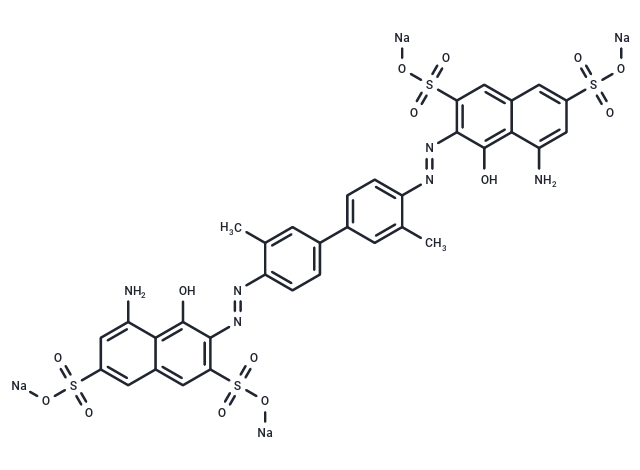Shopping Cart
Remove All Your shopping cart is currently empty
Your shopping cart is currently empty
Diphenyl Blue (Direct Blue 14) (Direct Blue 14) is used as a dye for a group of azo dye.

| Pack Size | Price | USA Warehouse | Global Warehouse | Quantity |
|---|---|---|---|---|
| 5 g | $29 | Inquiry | Inquiry |
| Description | Diphenyl Blue (Direct Blue 14) (Direct Blue 14) is used as a dye for a group of azo dye. |
| Cell Research | I. Analysis and standardization of azo dyes 1. Dye calibration: Dissolve Diphenyl Blue in an appropriate solvent (such as water or an organic solvent) and use it as a standard solution. Compare it with other azo dyes to be tested. 2. Staining experiment: Use Diphenyl Blue to perform staining experiments and compare its color changes under different conditions (such as different pH, temperature or solvent environments). 3. Performance test: Use a colorimeter or spectrophotometer to test the absorbance and other optical properties of the dye to evaluate its staining performance. II. Dye stability and reactivity study 1. Stability test: Store Diphenyl Blue solution under different temperature, pH or light conditions, measure its color changes regularly, and evaluate the stability of the dye. 2. Reactivity study: React with other chemical substances (such as metal ions, acid-base substances, etc.) to test the chemical reactivity of Diphenyl Blue. III. Cell staining 1. Solution preparation: Prepare 0.4% trypan blue with 0.85% Nacl. For example, 400 mg of trypan blue is dissolved in 100 mL of 0.85% Nacl. 2. Cell staining: Add Diphenyl Blue solution to the cell culture medium and incubate for a certain period of time (usually 30 minutes to 1 hour) to stain the cells. 3. Microscopic observation: Use a microscope to observe the staining effect, and measure the absorbance with a spectrophotometer to further analyze the intensity of the staining. IV. Quantitative analysis of dye behavior: 1. Solubility test: Dissolve different concentrations of Diphenyl Blue in various solvents, measure its solubility and observe the color change of the solution. 2. Absorbance measurement: Use a spectrophotometer to measure the absorbance of the solution at different wavelengths, draw an absorption spectrum, and analyze the optical properties of the dye. |
| Synonyms | Direct Blue 14 |
| Molecular Weight | 960.81 |
| Formula | C34H24N6Na4O14S4 |
| Cas No. | 72-57-1 |
| Smiles | CC1=CC(C2=CC=C(/N=N/C3=C(S(=O)(O[Na])=O)C=C4C=C(S(=O)(O[Na])=O)C=C(N)C4=C3O)C(C)=C2)=CC=C1/N=N/C5=C(S(=O)(O[Na])=O)C=C6C=C(S(=O)(O[Na])=O)C=C(N)C6=C5O |
| Relative Density. | 1.007 g/mL at 20°C |
| Color | Black |
| Appearance | Solid |
| Storage | keep away from direct sunlight | Powder: -20°C for 3 years | In solvent: -80°C for 1 year | Shipping with blue ice/Shipping at ambient temperature. | |||||||||||||||||||||||||
| Solubility Information | H2O: 10 mg/mL (10.41 mM), Sonication is recommended. DMSO: 8 mg/mL (8.33 mM), Sonication is recommended. | |||||||||||||||||||||||||
Solution Preparation Table | ||||||||||||||||||||||||||
DMSO/H2O
H2O
| ||||||||||||||||||||||||||
| Size | Quantity | Unit Price | Amount | Operation |
|---|

Copyright © 2015-2026 TargetMol Chemicals Inc. All Rights Reserved.